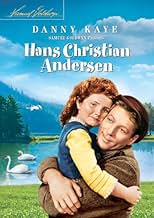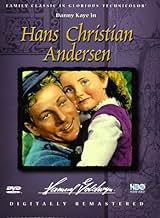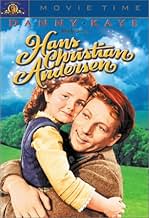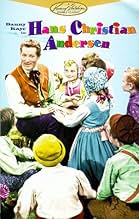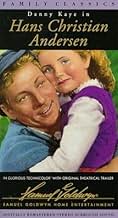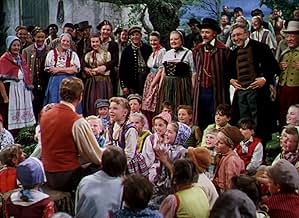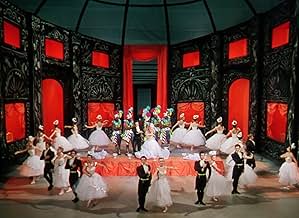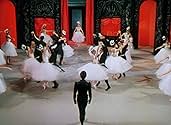CALIFICACIÓN DE IMDb
6.9/10
4.5 k
TU CALIFICACIÓN
Un cuento de hadas sobre el gran hilandero de cuento de Dinamarca llamado Hans Christian Andersen.Un cuento de hadas sobre el gran hilandero de cuento de Dinamarca llamado Hans Christian Andersen.Un cuento de hadas sobre el gran hilandero de cuento de Dinamarca llamado Hans Christian Andersen.
- Dirección
- Guionistas
- Elenco
- Nominado a 6 premios Óscar
- 10 nominaciones en total
Zizi Jeanmaire
- Doro
- (as Jeanmaire The Famous French Ballerina)
Joseph Walsh
- Peter
- (as Joey Walsh)
Peter J. Votrian
- Lars
- (as Peter Votrian)
Lee Aaker
- Little Boy
- (sin créditos)
Patsy Bangs
- Dancer
- (sin créditos)
Arthur Berkeley
- Townsman
- (sin créditos)
Opiniones destacadas
10llltdesq
Whoever reviewed this film for Maltin's Guide (I wish they'd indicate who the reviewer is by initials or something. It'd make the book more useful) does not share my tastes. I personally don't care that it bears no relation to Andersen's life. They admit it up front. Judge a film by itself, not on it's supposed relation to reality! Given Andersen's real life and his moody, pessemistic nature, I doubt being more accurate would have been a good thing. The score is beautiful, the sets and Costumes are great and Danny Kaye was wonderful! I haven't seen the movie for a couple of years and I stll remember most of the score! Granted, it's not one of the all-time greats, but it's better than the Maltin review implies. A worthy effort. Recommended.
Every single biopic of a creative artist tells the same story, whether it's true or not: the Philistine World, or some part thereof, rejects the artist, and fails to see his greatness; but later on, perhaps during his lifetime, perhaps not, it sees the error of its ways. That happens here. Hans Christian Andersen is a village cobbler whose compulsive inventiveness is little thought of until he makes good in Copenhagen, after which...
But there's much more going on.
There's no doubt that Andersen was a great artist, in some sense. `The Ugly Duckling' and `The Emperor's New Clothes' are two of the greatest short stories - fables, folktales - all of these - ever composed. But he had his limitations. There were many kinds of stories he just couldn't write. His fertile talent for anthropomorphising was often a millstone. In many respects he seems to have been a childish and naive man. But get this: all of these limitations make it onto the screen. Both the story and Danny Kaye's performance (a great performance) make Andersen into a human being who is NOT the greatest storyteller since Shakespeare, but who can be admired for what he is.
The main story isn't the `unrecognised genius' bit: it's a story of unrequited love. While in Copenhagen Andersen spends most of his time banging his head against the wall over an unattainable ballerina, whose interest in him is, as they say, purely professional. He manages to be quite cruel to a close friend in the process, right up to the point where it's unclear that a reconciliation is possible. (Indeed, it's unclear whether or not one occurs.) When he realises what a fool he's been he just trudges back, defeated, to his village. And it's here we have the obligatory scene where the villagers realise how great he was after all, mainly by singing the highly memorable refrains of the movie's songs, one after the other. Well, the film needed some ending. I'm inclined to forgive this one.
There's also a lengthy Little Mermaid ballet - seven minutes long? more? - danced in its entirety. (We see a LOT of the ballerina's craft in Copenhagen.) This sort of thing wasn't too unusual in the 1950s but it's a genuine gamble in context - and one that I think pays off. By the time the ballet appears the cheery story of an eccentric village storyteller had become surprisingly dark. Vidor, it seems, would rather risk having people leave the cinema than insult those who remain. Good for him. I can't claim that this film works in every respect, and perhaps you won't like it, but I'm sure you won't feel cheated by it.
But there's much more going on.
There's no doubt that Andersen was a great artist, in some sense. `The Ugly Duckling' and `The Emperor's New Clothes' are two of the greatest short stories - fables, folktales - all of these - ever composed. But he had his limitations. There were many kinds of stories he just couldn't write. His fertile talent for anthropomorphising was often a millstone. In many respects he seems to have been a childish and naive man. But get this: all of these limitations make it onto the screen. Both the story and Danny Kaye's performance (a great performance) make Andersen into a human being who is NOT the greatest storyteller since Shakespeare, but who can be admired for what he is.
The main story isn't the `unrecognised genius' bit: it's a story of unrequited love. While in Copenhagen Andersen spends most of his time banging his head against the wall over an unattainable ballerina, whose interest in him is, as they say, purely professional. He manages to be quite cruel to a close friend in the process, right up to the point where it's unclear that a reconciliation is possible. (Indeed, it's unclear whether or not one occurs.) When he realises what a fool he's been he just trudges back, defeated, to his village. And it's here we have the obligatory scene where the villagers realise how great he was after all, mainly by singing the highly memorable refrains of the movie's songs, one after the other. Well, the film needed some ending. I'm inclined to forgive this one.
There's also a lengthy Little Mermaid ballet - seven minutes long? more? - danced in its entirety. (We see a LOT of the ballerina's craft in Copenhagen.) This sort of thing wasn't too unusual in the 1950s but it's a genuine gamble in context - and one that I think pays off. By the time the ballet appears the cheery story of an eccentric village storyteller had become surprisingly dark. Vidor, it seems, would rather risk having people leave the cinema than insult those who remain. Good for him. I can't claim that this film works in every respect, and perhaps you won't like it, but I'm sure you won't feel cheated by it.
10arosedec
This was the movie that caused me to fall in love with Danny Kaye. I still love watching this movie more than 20 years after I saw it for the first time on television. I love his gentle nature with the children, in particular the little girl he sings "Thumbalina" to. Fabricated or not, this is one of his best films showing the true diversity of an incredibly talented man. Danny Kaye was surely one of the last of a dying Hollywood breed.
So the opening written words say to us the very thing that many across the movie forums have failed to spot, namely that they wasn't going for first tier autobiographical on this! just a celebration of the name and his work is all.
Who better to bring the great Dane to the screen than the ebullient Danny Kaye, his exuberant approach to the topic befits the glorious colour that positively sparkles in every frame of Charles Vidor's film.
The story tracks the Cobbler Andersen as he leaves his hometown of Odense to seek a new life in the beautiful city of Copenhagen. It is here that he becomes known for his stories that bring about much joy to the children of Denmark - and here that he writes his glorious ballet version of The Little Mermaid. He gets into scrapes, he falls for a pretty girl, and most of all he discovers his vocation in life, this is indeed a delightful fairytale in itself.
Sit back and enjoy The Emperor's New Clothes, Wonderful Copenhagen, Thumberlina and The Ugly Duckling, and then fall silenct for the 15 minute showing of The Little Mermaid in all its balletic glory. Hans Christian Andersen is a smashingly buoyant film, one that may come wrapped up in treacle for some folk, but for those of us with a sweet filmic tooth then the pleasures are there to be had. 8/10
Who better to bring the great Dane to the screen than the ebullient Danny Kaye, his exuberant approach to the topic befits the glorious colour that positively sparkles in every frame of Charles Vidor's film.
The story tracks the Cobbler Andersen as he leaves his hometown of Odense to seek a new life in the beautiful city of Copenhagen. It is here that he becomes known for his stories that bring about much joy to the children of Denmark - and here that he writes his glorious ballet version of The Little Mermaid. He gets into scrapes, he falls for a pretty girl, and most of all he discovers his vocation in life, this is indeed a delightful fairytale in itself.
Sit back and enjoy The Emperor's New Clothes, Wonderful Copenhagen, Thumberlina and The Ugly Duckling, and then fall silenct for the 15 minute showing of The Little Mermaid in all its balletic glory. Hans Christian Andersen is a smashingly buoyant film, one that may come wrapped up in treacle for some folk, but for those of us with a sweet filmic tooth then the pleasures are there to be had. 8/10
A lot of the comments previously made here are true and this certainly isn't any kind of real biographical film of Hans Christian Anderson. But one must remember that Samuel Goldwyn was primarily making this film as children's entertainment. And on that level he succeeded brilliantly.
In fact at the age of 5 in the cinema in Brooklyn this was the first movie on the big screen I ever remember seeing. My father was a big Danny Kaye fan so the whole family went to see it. And of course one of the first long-playing records we had in our house was the soundtrack to that film.
Another reviewer said that Frank Loesser's score was the highlight for him in the film. I don't think Danny Kaye ever had better material to sing with on the screen. Up to this point he got by with stuff especially written for him by his wife Sylvia Fine. He proved here in Hans Christian Anderson that he could definitely succeed without it.
Anyway when I view this film I'm five years old again. You will be too if you see it.
In fact at the age of 5 in the cinema in Brooklyn this was the first movie on the big screen I ever remember seeing. My father was a big Danny Kaye fan so the whole family went to see it. And of course one of the first long-playing records we had in our house was the soundtrack to that film.
Another reviewer said that Frank Loesser's score was the highlight for him in the film. I don't think Danny Kaye ever had better material to sing with on the screen. Up to this point he got by with stuff especially written for him by his wife Sylvia Fine. He proved here in Hans Christian Anderson that he could definitely succeed without it.
Anyway when I view this film I'm five years old again. You will be too if you see it.
¿Sabías que…?
- TriviaIn order to cover the necessary camera tricks, and to add "magic" to the Little Mermaid ballet, it was decided that, rather than presenting it as an actual ballet, they would have Hans imagine how it would look. This allowed them to do things on the screen which would be impossible on the stage.
- ErroresDuring the "Wonderful, Wonderful Copenhagen" song the concertina player directly behind the singer never moves his fingers on the keys.
- Créditos curiososOpening credits: "Once upon a time there lived in Denmark a great storyteller named Hans Christian Andersen. This is not the story of his life, but a fairy tale about this great spinner of fairy tales."
- ConexionesFeatured in Siskel & Ebert & the Movies: The Movies We Loved as Kids (1991)
- Bandas sonorasThe King's New Clothes
(uncredited)
Music and Lyrics by Frank Loesser
Sung by Danny Kaye and children
Reprised by Kaye, children, and Chorus in the Finale
Selecciones populares
Inicia sesión para calificar y agrega a la lista de videos para obtener recomendaciones personalizadas
- How long is Hans Christian Andersen?Con tecnología de Alexa
Detalles
- Fecha de lanzamiento
- País de origen
- Sitio oficial
- Idioma
- También se conoce como
- Hans Christian Andersen und die Tänzerin
- Locaciones de filmación
- Productora
- Ver más créditos de la compañía en IMDbPro
Taquilla
- Presupuesto
- USD 4,000,000 (estimado)
- Tiempo de ejecución1 hora 52 minutos
- Relación de aspecto
- 1.33 : 1
Contribuir a esta página
Sugiere una edición o agrega el contenido que falta

Principales brechas de datos
By what name was Hans Christian Andersen (1952) officially released in India in English?
Responda

